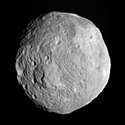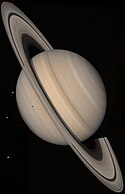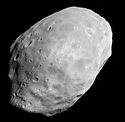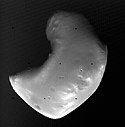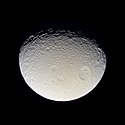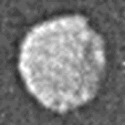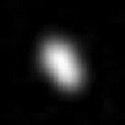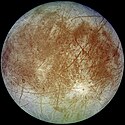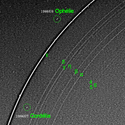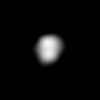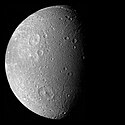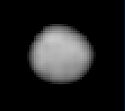Liste der Entdeckungen der Planeten und ihrer Monde
Diese Liste zeigt die Abfolge der Erstbeobachtungen von bis dahin unbekannten Planeten und Monden im Sonnensystem.
Zum Vergleich sind auch die Entdeckungszeiten der ersten sechs Asteroiden enthalten. Nach diesen sechs wurden jedes Jahr weitere Kleinplaneten gefunden. Die ersten vier dieser Erfolge verteilten sich jedoch über einige Jahre. Diese vier Objekte wurden zu jener Zeit für vollwertige Planeten gehalten. Aus dem gleichen Grund ist auch Pluto aufgeführt, der bis 2006 den Status eines Planeten hatte und seitdem nur noch als Zwergplanet gilt.
Die Namensgebungen fanden nicht immer gleichzeitig mit der Entdeckung des jeweiligen Himmelskörpers statt.
Die Tabelle ist nach dem Datum der Entdeckung bzw. Veröffentlichung sortiert.
- i: Datum der ersten Aufzeichnung (Foto etc.)
- o: Datum der ersten visuellen Beobachtung, durchs Teleskop oder auf Fotoplatte (der Zeitpunkt der Entdeckung)
- p: Datum der Veröffentlichung
Bemerkung: Monde, die mit einem Sternchen (*) markiert sind, haben eine komplizierte Geschichte ihrer Entdeckung. Manche Monde wurden erst nach Jahren bestätigt, andere gingen „verloren“ und wurden später wiederentdeckt. Wieder andere wurden erst Jahre nach der Aufnahme bei der Auswertung auf Fotos der Voyager-Sonden gefunden.
Legende
Die Planeten, Zwergplaneten und ihre natürlichen Satelliten sind in den folgenden Farben markiert:
| Erdähnliche Planeten | Gasplaneten | Zwergplaneten |
| Merkur | Jupiter | Ceres |
| Venus | Saturn | Pluto |
| Erde | Uranus | Makemake |
| Mars | Neptun | Eris |
| Haumea |
Urgeschichte und Altertum
| Entdeckung | Name | Benen- nung | Bild | Planet/Nummer Benennung | Anmerkungen |
|---|---|---|---|---|---|
| Erde |  | Diese Liste ist nach der vermeintlichen Entfernung der Planeten zur Erde geordnet; eine so geordnete Liste wurde erstmals von den griechischen Stoikern erstellt. | |||
| Mond | Erdmond | ||||
| Merkur |  | ||||
| Venus |  | ||||
| Sonne |  | ||||
| Mars |  | ||||
| Jupiter |  | ||||
| Saturn |  | ||||
17. Jahrhundert
| Entdeckung | Name | Benen- nung | Bild | Planet/Nummer Benennung | Anmerkungen |
|---|---|---|---|---|---|
| o: 7. Januar 1610 p: 13. März 1610 | Kallisto |  | Jupiter IV | Galileo Galilei (Galileische Monde), unabhängig davon Simon Marius. | |
| Io |  | Jupiter I | |||
| Europa |  | Jupiter II | |||
| o: 11. Januar 1610 p: 13. März 1610 | Ganymed |  | Jupiter III | ||
| o: 25. März 1655 p: 5. März 1656 | Titan |  | Saturn VI | Huygens. Huygens „veröffentlichte“ seine Entdeckung zuerst als Anagramm, abgeschickt am 13. Juni 1655. | |
| o: 25. Oktober 1671 p: 1673 | Iapetus | Saturn VIII | Cassini. Cassini veröffentlichte diese beiden Entdeckungen in Eine Entdeckung von zwei neuen Planeten um Saturn, gemacht im königlichen Pariser Observatorium von Signor Cassini, Philosophische Vorfälle 8 (1673), pp. 5178-5185. Möglicherweise gibt es auch frühere Veröffentlichungen im Journal des scavans. | ||
| o: 23. Dezember 1672 p: 1673 | Rhea |  | Saturn V | ||
| o: 21. März 1684 p: 22. April 1686 | Tethys |  | Saturn III | Cassini. Cassini veröffentlichte diese zwei Entdeckungen am 22. April 1686, geprüft durch Ein Auszug des Journal Des Scavans vom April 22 st. N. 1686, mit der Annahme von zwei neuen Satelliten des Saturns, kürzlich entdeckt vom Herrn Cassini am königlichen Observatorium in Paris, Philosophische Vorfälle 16 (1686–1692) pp. 79-85. In seiner Arbeit Kosmotheeoros[1] (1698 posthum veröffentlicht), bezieht sich Christiaan Huygens darauf: „Jupiter hat, wie man sieht, seine vier und Saturn seine fünf Monde um sich, alle in deren eigenen Umlaufbahnen.“ | |
| Dione |  | Saturn IV | |||
18. Jahrhundert
| Entdeckung | Name | Benen- nung | Bild | Planet/Nummer Benennung | Anmerkungen |
|---|---|---|---|---|---|
| o: 13. März 1781 p: 26. April 1781 | Uranus |  | 7. Planet (1781) | Herschel.[2] Herschel gab am 26. April 1781 bekannt, Uranus entdeckt zu haben, und war überzeugt, dass es ein „Komet“ ist.[3] | |
| o: 11. Januar 1787 p: 1787 | Titania |  | Uranus III | Herschel | |
| Oberon |  | Uranus IV | Herschel | ||
| o: 28. August 1789 p: 1790 | Enceladus |  | Saturn II | Herschel | |
| o: 17. September 1789 p: 1790 | Mimas |  | Saturn I | Herschel[4] | |
19. Jahrhundert
| Entdeckung | Name | Benen- nung | Bild | Planet/Nummer Benennung | Anmerkungen |
|---|---|---|---|---|---|
| o: 1. Januar 1801 | (1) Ceres |  | 8. Planet (1801) Asteroid (1851) Zwergplanet (2006) | Piazzi | |
| o: 28. März 1802 | (2) Pallas | 9. Planet (1802) Asteroid (1851) | Olbers | ||
| o: 1. September 1804 | (3) Juno |  | 10. Planet (1804) Asteroid (1851) | Harding | |
| o: 29. März 1807 | (4) Vesta |  | 11. Planet (1807) Asteroid (1851) | Olbers | |
| o: 8. Dezember 1845 | (5) Astraea | 12. Planet (1845) Asteroid (1851) | Hencke[5] | ||
| o: 23. September 1846 | Neptun |  | 13. Planet (1846) 8. Planet (1851) | Leverrier, Adams, Galle, d’Arrest | |
| o: 10. Oktober 1846 | Triton |  | Neptun I | Lassell[6][7] | |
| o: 1. Juli 1847 | (6) Hebe | 14. Planet (1847) Asteroid (1851) | Hencke[8] Mit der Entdeckung von (6) Hebe im Jahre 1847 begann eine wahre Flut Neuentdeckungen von Asteroiden. Daher wurde auf Vorschlag von Alexander von Humboldt im Jahre 1851 die Zahl der (großen) Planeten auf acht begrenzt, und der neue Begriff der Asteroiden (auch: Planetoiden oder Kleinplaneten) eingeführt. | ||
| o: 16. September 1848 | Hyperion |  | Saturn VII | W.C. Bond, G.P. Bond, Lassell[9][10] | |
| o: 24. Oktober 1851 | Ariel |  | Uranus I | Lassell[11] | |
| Umbriel |  | Uranus II | Lassell[12] | ||
| o: 12. August 1877 | Deimos |  | Mars II | Hall[13][14][15] | |
| o: 18. August 1877 | Phobos | Mars I | Hall[16][17][18] | ||
| o: 9. September 1892 p: 4. Oktober 1892 | Amalthea | Jupiter V | Barnard[19] | ||
| i: 16. August 1898 o: 17. März 1899 | Phoebe |  | Saturn IX | Pickering[20][21] | |
20. Jahrhundert
1901–1970
| Entdeckung | Name | Benen- nung | Bild | Planet/Nummer Benennung | Anmerkungen |
|---|---|---|---|---|---|
| i: 3. Dezember 1904 p: 6. Januar 1905 | Himalia | Jupiter VI | Perrine[22][23][24][25] | ||
| i: 2. Januar 1905 p: 27. Februar 1905 | Elara | Jupiter VII | Perrine[26][27][28] | ||
| o: 17. April 1904 p: 28. April 1905 | „Themis“ |  | „Saturn X“ (fälschlich) | Pickering[29][30] | |
| i: 27. Januar 1908 o: 28. Februar 1908 p: 1. März 1908 | Pasiphae | Jupiter VIII | Melotte[31][32] | ||
| i: 21. Juli 1914 | Sinope | Jupiter IX | Nicholson[33] | ||
| i: 23. Januar 1930 o: 18. Februar 1930 p: 13. März 1930 | Pluto |  | 9. Planet (1930) Zwergplanet (2006) | Tombaugh[34] | |
| i: 6. Juli 1938 | Lysithea | Jupiter X | Nicholson[35] | ||
| i: 30. Juli 1938 | Carme | Jupiter XI | Nicholson[36] | ||
| i: 16. Februar 1948 | Miranda |  | Uranus V | Kuiper[37] | |
| i: 1. Mai 1949 | Nereid |  | Neptun II | Kuiper[38] | |
| i: 28. Dezember 1951 | Ananke | Jupiter XII | Nicholson[39] | ||
| i: 15. Dezember 1966 | Janus* | S/1966 S 2 | Saturn X | Dollfus (Dollfus sah entweder Janus oder Epimetheus) | |
| i: 18. Dezember 1966 | Epimetheus* | Saturn XI | Walker | ||
1971–1980
| Entdeckung | Name | Benen- nung | Bild | Planet/Nummer Benennung | Anmerkungen |
|---|---|---|---|---|---|
| i: 11. September 1974 p: 20. September 1974 | Leda | Jupiter XIII | Kowal[40] | ||
| i: 30. September 1975 p: 3. Oktober 1975 | Themisto* | S/1975 J 1 | Jupiter XVIII | Kowal (Entdeckt, dann aber wieder verloren) | |
| i: 13. April 1978 o: 22. Juni 1978 | Charon | S/1978 P 1 |  | Pluto I | Christy[41] |
| i: 8. Juli 1979 p: 23. November 1979 | Adrastea | S/1979 J 1 | Jupiter XV | Jewitt, Danielson / Voyager 2[42][43] | |
| i: 19. Februar 1980 | Janus* | S/1980 S 1 | Saturn X | (Von Voyager 1 bestätigt) | |
| i: 26. Januar 1980 | Epimetheus* | S/1980 S 3 | Saturn XI | (Von Voyager 1 bestätigt) | |
| i: 1. März 1980 | Helene | S/1980 S 6 |  | Saturn XII | Laques, Lecacheux |
| i: 13. März 1980 | Calypso | S/1980 S 25 | Saturn XIV | Pascu, Seidelmann, Baum, Currie | |
| i: 8. April 1980 | Telesto | S/1980 S 13 | Saturn XIII | Smith, Reitsema, Larson, Fountain, Voyager 1 | |
| i: 5. März 1979 p: 28. April 1980 | Thebe | S/1979 J 2 |  | Jupiter XIV | Synnott, Voyager 1 |
| i: 4. März 1979 p: 26. August 1980 | Metis | S/1979 J 3 | Jupiter XVI | Synnott, Voyager 1 | |
| o: Oktober 1980 | Atlas | S/1980 S 28 |  | Saturn XV | Terrile, Voyager 1 |
| Prometheus | S/1980 S 27 | Saturn XVI | Collins, Voyager 1 | ||
| Pandora | S/1980 S 26 | Saturn XVII | Collins, Voyager 1 | ||
1981–1990
| Entdeckung | Name | Benen- nung | Bild | Planet/Nummer Benennung | Anmerkungen |
|---|---|---|---|---|---|
| i: 30. Dezember 1985 | Puck | S/1985 U 1 |  | Uranus XV | Synnott, Voyager 2 |
| i: 3. Januar 1986 | Juliet | S/1986 U 2 | Uranus XI | Synnott, Voyager 2 | |
| Portia | S/1986 U 1 | Uranus XII | Synnott, Voyager 2 | ||
| i: 9. Januar 1986 | Cressida | S/1986 U 3 | Uranus IX | Synnott, Voyager 2 | |
| i: 13. Januar 1986 | Desdemona | S/1986 U 6 | Uranus X | Synnott, Voyager 2 | |
| Rosalind | S/1986 U 4 | Uranus XIII | Synnott, Voyager 2 | ||
| Belinda | S/1986 U 5 |  | Uranus XIV | Synnott, Voyager 2 | |
| i: 20. Januar 1986 | Cordelia | S/1986 U 7 |  | Uranus VI | Terrile, Voyager 2 |
| Ophelia | S/1986 U 8 |  | Uranus VII | Terrile, Voyager 2 | |
| i: 23. Januar 1986 | Bianca | S/1986 U 9 | Uranus VIII | Smith, Voyager 2 | |
| i: 16. Juni 1989 p: 7. Juli 1989 | Proteus | S/1989 N 1 |  | Neptun VIII | Synnott, Voyager 2 |
| i: 28. Juli 1989 p: 2. August 1989 | Larissa | S/1989 N 2 | Neptun VII | Reitsema, Hubbard, Lebofsky, Tholen, Voyager 2 | |
| Despina | S/1989 N 3 | Neptun V | Synnott, Voyager 2 | ||
| Galatea | S/1989 N 4 |  | Neptun VI | Synnott, Voyager 2 | |
| i: 18. September 1989 p: 29. September 1989 | Thalassa | S/1989 N 5 | Neptun IV | Terrile, Voyager 2 | |
| Naiad | S/1989 N 6 | Neptun III | Terrile, Voyager 2 | ||
| i: 22. August 1981 p: 16. Juli 1990 | Pan* | S/1981 S 13 | Saturn XVIII | Showalter, Voyager 2 |
1991–2000
| Entdeckung | Name | Benen- nung | Bild | Planet/Nummer Benennung | Anmerkungen |
|---|---|---|---|---|---|
| i: 23. August 1981 p: 14. April 1995 | S/1981 S 14 siehe unten: Methone | Saturn | Gordon, Murray und Beurle[44] | ||
| i: 6. September 1997 p: 31. Oktober 1997 | Caliban | S/1997 U 1 | Uranus XVI | Gladman, Nicholson, Burns, Kavelaars | |
| Sycorax | S/1997 U 2 | Uranus XVII | Gladman, Nicholson, Burns, Kavelaars | ||
| i: 18. Januar 1986 p: 18. März 1999 | Perdita | S/1986 U 10* | Uranus | Karkoschka, Voyager 2 | |
| i: 18. Juli 1999 | Setebos | S/1999 U 1 | Uranus XIX | Kavelaars, Gladman, Holman, Petit, Scholl | |
| Stephano | S/1999 U 2 | Uranus XX | Gladman, Holman, Kavelaars, Petit, Scholl | ||
| Prospero | S/1999 U 3 | Uranus XVIII | Holman, Kavelaars, Gladman, Petit, Scholl | ||
| i: 6. Oktober 1999 o: 18. Juli p: 20. Juli 2000 | Callirrhoe | S/1999 J 1 | Jupiter XVII | Scotti, Spahr, McMillan, Larsen, Montani, Gleason, Gehrels | |
| i: 7. August 2000 | Ymir | S/2000 S 1 | Saturn XIX | Gladman | |
| Paaliaq | S/2000 S 2 | Saturn XX | Gladman | ||
| Kiviuq | S/2000 S 5 | Saturn XXIV | Gladman | ||
| i: 23. September 2000 | Siarnaq | S/2000 S 3 | Saturn XXIX | Gladman, Kavelaars | |
| Tarvos | S/2000 S 4 | Saturn XXI | Kavelaars, Gladman | ||
| Ijiraq | S/2000 S 6 | Saturn XXII | Kavelaars, Gladman | ||
| Thrymr | S/2000 S 7 | Saturn XXX | Gladman, Kavelaars | ||
| Skathi | S/2000 S 8 | Saturn XXVII | Kavelaars, Gladman | ||
| Mundilfari | S/2000 S 9 | Saturn XXV | Gladman, Kavelaars | ||
| Erriapus | S/2000 S 10 | Saturn XXVIII | Kavelaars, Gladman | ||
| Suttungr | S/2000 S 12 | Saturn XXIII | Gladman, Kavelaars | ||
| 9. November 2000 p: 19. Dezember 2000 | Albiorix | S/2000 S 11 | Saturn XXVI | Holman, Spahr | |
| i: 21. November 2000 p: 25. November 2000 | Themisto* | S/2000 J 1 | Jupiter XVIII | Sheppard, Jewitt, Fernández, Magnier (Wiederentdeckt) |
21. Jahrhundert
2001–2010
| Entdeckung | Name | Benen- nung | Bild | Planet/Nummer Benennung | Anmerkungen |
|---|---|---|---|---|---|
| i: 23. November 2000 p: 5. Januar 2001 | Kalyke | S/2000 J 2 | Jupiter XXIII | Sheppard, Jewitt, Fernández, Magnier, Dahm, Evans | |
| Iocaste | S/2000 J 3 | Jupiter XXIV | |||
| Erinome | S/2000 J 4 | Jupiter XXV | |||
| Harpalyke | S/2000 J 5 | Jupiter XXII | |||
| Isonoe | S/2000 J 6 | Jupiter XXVI | |||
| Praxidike | S/2000 J 7 | Jupiter XXVII | |||
| i: 25. November 2000 p: 5. Januar 2001 | Megaclite | S/2000 J 8 | Jupiter XIX | Sheppard, Jewitt, Fernández, Magnier, Dahm, Evans | |
| Taygete | S/2000 J 9 | Jupiter XX | |||
| i: 26. November 2000 p: 5. Januar 2001 | Chaldene | S/2000 J 10 | Jupiter XXI | Sheppard, Jewitt, Fernández, Magnier, Dahm, Evans | |
| i: 5. Dezember 2000 p: 5. Januar 2001 | Dia* | S/2000 J 11 | Jupiter LIII | Sheppard, Jewitt, Fernández, Magnier, Dahm, Evans | |
| i: 9. Dezember 2001 p: 16. Mai 2002 | Hermippe | S/2001 J 3 | Jupiter XXX | Sheppard, Jewitt, Kleyna | |
| Eurydome | S/2001 J 4 | Jupiter XXXII | |||
| Sponde | S/2001 J 5 | Jupiter XXXVI | |||
| Kale | S/2001 J 8 | Jupiter XXXVII | |||
| i: 10. Dezember 2001 p: 16. Mai 2002 | Autonoe | S/2001 J 1 | Jupiter XXVIII | Sheppard, Jewitt, Kleyna | |
| i: 11. Dezember 2001 p: 16. Mai 2002 | Thyone | S/2001 J 2 | Jupiter XXIX | Sheppard, Jewitt, Kleyna | |
| Pasithee | S/2001 J 6 | Jupiter XXXVIII | |||
| Euanthe | S/2001 J 7 | Jupiter XXXIII | |||
| Orthosie | S/2001 J 9 | Jupiter XXXV | |||
| Euporie | S/2001 J 10 | Jupiter XXXIV | |||
| Aitne | S/2001 J 11 | Jupiter XXXI | |||
| i: 13. August 2001 p: 30. September 2002 | Trinculo | S/2001 U 1 | Uranus XXI | Holman, Kavelaars, Milisavljevic | |
| i: 31. Oktober 2002 p: 18. Dezember 2002 | Arche | S/2002 J 1 | Jupiter XLIII | Sheppard, Meech, Hsieh, Tholen, Tonry | |
| i: 13. August 2002 p: 13. Januar 2003 | Laomedeia | S/2002 N 3 | Neptun XII | Holman, Kavelaars, Grav, Fraser, Milisavljevic | |
| i: 14. August 2002 p: 13. Januar 2003 | Halimede | S/2002 N 1 | Neptun IX | Holman, Kavelaars, Grav, Fraser, Milisavljevic | |
| Sao | S/2002 N 2 | Neptun XI | |||
| i: 5. Februar 2003 p: 4. März 2003 | Eukelade | S/2003 J 1 | Jupiter XLVII | Sheppard, Jewitt, Kleyna, Fernández, Hsieh | |
| S/2003 J 2 | Jupiter | ||||
| Eupheme | S/2003 J 3 | Jupiter | |||
| S/2003 J 4 | Jupiter | ||||
| i: 6. Februar 2003 p: 4. März 2003 | Eirene | S/2003 J 5 | Jupiter | Sheppard, Jewitt, Kleyna, Fernández, Hsieh | |
| Helike | S/2003 J 6 | Jupiter XLV | |||
| i: 8. Februar 2003 p: 4. März 2003 | Aoede | S/2003 J 7 | Jupiter XLI | Sheppard, Jewitt, Kleyna, Fernández, Hsieh | |
| Hegemone | S/2003 J 8 | Jupiter XXXIX | |||
| i: 6. Februar 2003 p: 7. März 2003 | S/2003 J 9 | Jupiter | Sheppard, Jewitt, Kleyna, Fernández | ||
| S/2003 J 10 | Jupiter | ||||
| Kallichore | S/2003 J 11 | Jupiter XLIV | |||
| i: 8. Februar 2003 p: 7. März 2003 | S/2003 J 12 | Jupiter | Sheppard, Jewitt, Kleyna, Fernández | ||
| i: 5. Februar 2003 p: 11. April 2003 | Narvi | S/2003 S 1 | Saturn XXXI | Sheppard, Jewitt, Kleyna | |
| i: 9. Februar 2003 p: 11. April 2003 | Cyllene | S/2003 J 13 | Jupiter XLVIII | Sheppard, Jewitt, Kleyna | |
| i: 8. Februar 2003 p: 11. April 2003 | Kore | S/2003 J 14 | Jupiter XLIX | Sheppard, Jewitt, Kleyna | |
| i: 6. Februar 2003 p: 11. April 2003 | Philophrosyne | S/2003 J 15 | Jupiter | Gladman, Sheppard, Jewitt, Kleyna, Kavelaars, Petit, Allen | |
| S/2003 J 16 | |||||
| i: 8. Februar 2003 p: 11. April 2003 | Herse | S/2003 J 17 | Jupiter L | Gladman, Sheppard, Jewitt, Kleyna, Kavelaars, Petit, Allen | |
| i: 6. Februar 2003 p: 11. April 2003 | S/2003 J 18 | Jupiter | Gladman, Kavelaars, Petit, Allen, Sheppard, Jewitt, Kleyna | ||
| i: 6. Februar 2003 p:30. April 2003 | S/2003 J 19 | Jupiter | Gladman, Sheppard, Jewitt, Kleyna, Kavelaars, Petit, Allen | ||
| i: 9. Februar 2003 p: 30. April 2003 | Carpo | S/2003 J 20 | Jupiter XLVI | Sheppard, Gladman, Kavelaars, Petit, Allen, Jewitt, Kleyna | |
| i: 6. Februar 2003 p: 30. Mai 2003 | Mneme | S/2003 J 21 | Jupiter XL | Sheppard, Jewitt, Kleyna, Gladman, Kavelaars, Petit, Allen | |
| i: 13. August 2001 p: 29. August 2003 | Ferdinand* | S/2001 U 2 | Uranus XXIV | 2001: Holman, Kavelaars, Milisavljevic; 2003: Scott S. Sheppard, David C. Jewitt | |
| i: 14. August 2002 p: 29. August 2003 | Neso* | S/2002 N 4 | Neptun XIII | Holman, Kavelaars, Grav, Fraser, Milisavljevic | |
| i: 29. August 2003 p: 3. September 2003 | Psamathe | S/2003 N 1 | Neptun X | Jewitt, Kleyna, Sheppard, Holman, Kavelaars | |
| i: 25. August 2003 p: 25. September 2003 | Mab | S/2003 U 1 | Uranus XXVI | Showalter, Lissauer | |
| Cupid | S/2003 U 2 | Uranus XXVII | |||
| i: 13. August 2001 8. Oktober 2003 | Francisco* | S/2001 U 3 | Uranus XXII | Holman, Kavelaars, Milisavljevic, Gladman | |
| i: 29. August 2003 p: 9. Oktober 2003 | Margaret | S/2003 U 3 | Uranus XXIII | Sheppard, Jewitt | |
| i: 9. Februar 2003 p: 25. Januar 2004 | Thelxinoe* | S/2003 J 22 | Jupiter XLII | Sheppard, Jewitt, Kleyna, Gladman, Kavelaars, Petit, Allen (Von 2003 gemachten Bildern) | |
| i: 6. Februar 2003 p: 4. Februar 2004 | S/2003 J 23* | Jupiter | Sheppard, Jewitt, Kleyna, Fernández | ||
| i: 1. Juni 2004 p: 16. August 2004 | Methone | S/2004 S 1 = S/1981 S 14? |  | Saturn XXXII | Porco, Charnoz, Brahic, Dones / Cassini-Huygens[45] |
| Pallene | S/2004 S 2 |  | Saturn XXXIII | Porco, Charnoz, Brahic, Dones / Cassini-Huygens[45] | |
| i: 21. Juni 2004 p: 9. September 2004 | S/2004 S 3* |  | Saturn | Murray, Porco et al. / Cassini-Huygens[46] | |
| i: 21. Juni 2004(?) p: 9. September 2004 | S/2004 S 4* | Saturn | Spitale, Porco et al. / Cassini-Huygens[46] | ||
| i: 21. Oktober 2004 o: 24. Oktober 2004 p: 8. November 2004 | Polydeuces | S/2004 S 5 | Saturn XXXIV | Porco et al. / Cassini-Huygens | |
| i: 28. Oktober 2004 p: 8. November 2004 | S/2004 S 6* | Saturn | Porco et al. / Cassini-Huygens | ||
| i: 12. Dezember 2004 p: 4. Mai 2005 | S/2004 S 7 | Saturn | Sheppard, Jewitt, Kleyna, Marsden[47] | ||
| Fornjot | S/2004 S 8 | Saturn XLII | |||
| Farbauti | S/2004 S 9 | Saturn XL | |||
| Aegir | S/2004 S 10 | Saturn XXXVI | |||
| Bebhionn | S/2004 S 11 | Saturn XXXVII | |||
| S/2004 S 12 | Saturn | ||||
| S/2004 S 13 | Saturn | ||||
| Hati | S/2004 S 14 | Saturn XLIII | |||
| Bergelmir | S/2004 S 15 | Saturn XXXVIII | |||
| i: 13. Dezember 2004 p: 4. Mai 2005 | Fenrir | S/2004 S 16 | Saturn XLI | Sheppard, Jewitt, Kleyna, Marsden[47] | |
| S/2004 S 17 | Saturn | ||||
| Bestla | S/2004 S 18 | Saturn XXXIX | |||
| i: 1. Mai 2005 p: 6. Mai 2005 | Daphnis | S/2005 S 1 |  | Saturn XXXV | Porco et al. / Cassini-Huygens |
| i: 21. Oktober 2003 o: 5. Januar 2005 p: 29. Juli 2005 | Eris | 2003 UB313 |  | Zwergplanet (2006) | Brown, Trujillo, Rabinowitz |
| i: 6. Mai 2004 o: 28. Dez 2004 p: 29. Juli 2005 | Haumea | 2003 EL61 | Zwergplanet (2008) | Brown, Trujillo, Rabinowitz | |
| o: 26. Januar 2005 p: 29. Juli 2005 | Hiʻiaka | S/2005 (136108) 1 | — | Haumea I | Brown, Trujillo, Rabinowitz |
| i: 31. März 2005 p: 29. Juli 2005 | Makemake | 2005 FY9 | Zwergplanet (2008) | Brown, Trujillo, Rabinowitz | |
| o: 30. Juni 2005 p: 29. Juli 2005 | Namaka | S/2005 (136108) 2 | — | Haumea II | Brown, Trujillo, Rabinowitz |
| i: 10. September 2005 p: 3. Oktober 2005 | Dysnomia | S/2005 (2003 UB313) 1 | Eris I | Brown, Trujillo, van Dam, Bouchez, Le Mignant, Campbell, Chin, Conrad, Hartman, Johansson, Lafon, Rabinowitz, Stomski, Summers, Wizinowich[48] | |
| i: 15. Mai 2005 o: 15. Juni 2005 p: 31. Oktober 2005 | Hydra | S/2005 P 1 |  | Pluto III | Weaver, Stern, Mutchler, Steffl, Buie, Merline, Spencer, Young, Young |
| Nix | S/2005 P 2 |  | Pluto II | ||
| i: 12. Dezember 2004 o: 6. März 2006(?) p: 26. Juni 2006 | Hyrrokkin | S/2004 S 19 | Saturn XLIV | Sheppard, Jewitt, Kleyna[49] | |
| i: 4. Januar 2006 o: 6. März 2006(?) p: 26. Juni 2006 | S/2006 S 1 | Saturn | Sheppard, Jewitt, Kleyna[49] | ||
| Kari | S/2006 S 2 | Saturn XLV | |||
| i: 5. Januar 2006 o: 6. März 2006 (?) p: 26. Juni 2006 | S/2006 S 3 | Saturn | |||
| Greip | S/2006 S 4 | Saturn LI | |||
| Loge | S/2006 S 5 | Saturn XLVI | |||
| Jarnsaxa | S/2006 S 6 | Saturn L | |||
| Surtur | S/2006 S 7 | Saturn XLVIII | |||
| Skoll | S/2006 S 8 | Saturn XLVII | |||
| i: 5. Januar 2006 o: 16. Januar 2007 (?) p: 13. April 2007 | Tarqeq | S/2007 S 1 | Saturn LII | Sheppard, Jewitt, Kleyna | |
| i: 18. Januar 2007 o: p: 1. Mai 2007 | S/2007 S 2 | Saturn | Sheppard, Jewitt, Kleyna | ||
| S/2007 S 3 | Saturn | ||||
| i: Juni 2004 o: 30. Mai 2007 p: 18. Juli 2007 | Anthe | S/2007 S 4 | Saturn XLIX | Cassini Imaging Science Team[50] | |
| i: 15. August 2008 p: 3. März 2009 | Aegaeon | S/2008 S 1 | Saturn LIII | Cassini Imaging Science Team[51] | |
| i: 26. Juli 2009 p: 2. November 2009 | S/2009 S 1 | Saturn | Cassini Imaging Science Team[52] |
Seit 2011
| Entdeckung | Name | Benen- nung | Bild | Planet/Nummer Benennung | Anmerkungen |
|---|---|---|---|---|---|
| i: 7. Sep. 2010 p: 1. Juni 2011 | S/2010 J 1 | Jupiter LI | Jacobson, Brozović, Gladman and Alexandersen[53] | ||
| S/2010 J 2 | Jupiter LII | Veillet[53] | |||
| i: 28. Juni 2011 p: 20. Juli 2011 | Kerberos | S/2011 (134340) 1 |  | Pluto IV | Showalter et al.[54] |
| i: 27. Sep. 2011 p: 29. Jan. 2012 | S/2011 J 1 | Jupiter LXXII | Sheppard[55] | ||
| S/2011 J 2 | Jupiter LVI | ||||
| i: 7. Juli 2012 p: 11. Juli 2012 | Styx | S/2012 (134340) 1 |  | Pluto V | Showalter et al.[56] |
| i: 19. August 2009 p: 15. Juli 2013 | Hippocamp | S/2004 N 1 | Neptun XIV | Showalter et al.[57] | |
| i: April 2015 p: 26. April 2016 | S/2015 (136472) 1 | Makemake | [58] | ||
| i: März 2016 p: Juni 2017 | S/2016 J 1 | Jupiter LIV | Sheppard et al.[59] | ||
| S/2017 J 1 | Jupiter LIX | ||||
| i: März 2016 p: 17. Juli 2018 | Valetudo | S/2016 J 2 | Jupiter LXII | Sheppard et al.[60] | |
| i: Februar 2016 p: 17. Juli 2018 | S/2017 J 2 | Jupiter LXIII | Sheppard et al.[61] | ||
| i: Februar 2016 p: 17. Juli 2018 | S/2017 J 3 | Jupiter LXIV | Sheppard et al.[62] | ||
| i: März 2017 p: 17. Juli 2018 | Pandia | S/2017 J 4 | Jupiter LXV | Sheppard et al.[63] | |
| i: März 2017 p: 17. Juli 2018 | S/2017 J 5 | Jupiter LXVI | Sheppard et al.[64] | ||
| i: Februar 2017 p: 17. Juli 2018 | S/2017 J 6 | Jupiter LXVII | Sheppard et al.[65] | ||
| i: Februar 2017 p: 17. Juli 2018 | S/2017 J 7 | Jupiter LXVIII | Sheppard et al.[66] | ||
| i: März 2017 p: 17. Juli 2018 | S/2017 J 8 | Jupiter LXIX | Sheppard et al.[67] | ||
| i: Februar 2017 p: 17. Juli 2018 | S/2017 J 9 | Jupiter LXX | Sheppard et al.[68] | ||
| i: März 2017 p: 17. Juli 2018 | Ersa | S/2018 J 1 | Jupiter LXXI | Sheppard et al.[69] | |
| i: Dezember 2004 p: 7. Oktober 2019 | Gridr | S/2004 S 20 | Saturn | Sheppard et al.[70] | |
| i: Dezember 2004 p: 7. Oktober 2019 | S/2004 S 21 | Saturn | Sheppard et al.[71] | ||
| i: Dezember 2004 p: 7. Oktober 2019 | Angrboda | S/2004 S 22 | Saturn | Sheppard et al.[72] | |
| i: Dezember 2004 p: 7. Oktober 2019 | Skrymir | S/2004 S 23 | Saturn | Sheppard et al.[73] | |
| i: Dezember 2004 p: 7. Oktober 2019 | S/2004 S 24 | Saturn | Sheppard et al.[74] | ||
| i: Dezember 2004 p: 7. Oktober 2019 | Gerd | S/2004 S 25 | Saturn | Sheppard et al.[75] | |
| i: Dezember 2004 p: 7. Oktober 2019 | S/2004 S 26 | Saturn | Sheppard et al.[76] | ||
| i: Dezember 2004 p: 7. Oktober 2019 | Eggther | S/2004 S 27 | Saturn | Sheppard et al.[77] | |
| i: Dezember 2004 p: 7. Oktober 2019 | S/2004 S 28 | Saturn | Sheppard et al.[78] | ||
| i: Dezember 2004 p: 7. Oktober 2019 | S/2004 S 29 | Saturn | Sheppard et al.[79] | ||
| i: Dezember 2004 p: 7. Oktober 2019 | Beli | S/2004 S 30 | Saturn | Sheppard et al.[80] | |
| i: Dezember 2004 p: 8. Oktober 2019 | S/2004 S 31 | Saturn | Sheppard et al.[81] | ||
| i: Dezember 2004 p: 8. Oktober 2019 | Gunnlod | S/2004 S 32 | Saturn | Sheppard et al.[82] | |
| i: Dezember 2004 p: 8. Oktober 2019 | Thiazzi | S/2004 S 33 | Saturn | Sheppard et al.[83] | |
| i: Dezember 2004 p: 8. Oktober 2019 | S/2004 S 34 | Saturn | Sheppard et al.[84] | ||
| i: Dezember 2004 p: 8. Oktober 2019 | Alvaldi | S/2004 S 35 | Saturn | Sheppard et al.[85] | |
| i: Dezember 2004 p: 8. Oktober 2019 | S/2004 S 36 | Saturn | Sheppard et al.[86] | ||
| i: Dezember 2004 p: 8. Oktober 2019 | S/2004 S 37 | Saturn | Sheppard et al.[87] | ||
| i: Dezember 2004 p: 8. Oktober 2019 | Geirrod | S/2004 S 38 | Saturn | Sheppard et al.[88] | |
| i: Dezember 2004 p: 8. Oktober 2019 | S/2004 S 39 | Saturn | Sheppard et al.[89] | ||
| i: Juli 2019 p: 16. November 2021 | S/2019 S 1 | Saturn | Edward Ashton et al.[90] |
Siehe auch
- Zeittafel Astronomie
- Liste der Monde von Planeten und Zwergplaneten
- Liste der Zwergplaneten des Sonnensystems
- Geschichte der Astronomie
- Liste der größten Objekte im Sonnensystem
Weblinks
Einzelnachweise
- ↑ The Cosmotheoros of Christiaan Huygens (1698)
- ↑ bibcode:1781RSPT...71..492H
- ↑ Account of a Comet, By Mr. Herschel, F. R. S.; Communicated by Dr. Watson, Jun. of Bath, F. R. S., Philosophical Transactions of the Royal Society of London, Volume 71, pp. 492-501.
- ↑ cosmovisions.com
- ↑ bibcode:1846MNRAS...7...27H
- ↑ adsabs.harvard.edu
- ↑ adsabs.harvard.edu
- ↑ bibcode:1848MNRAS...8..103H
- ↑ adsabs.harvard.edu
- ↑ adsabs.harvard.edu
- ↑ adsabs.harvard.edu
- ↑ adsabs.harvard.edu
- ↑ adsabs.harvard.edu
- ↑ adsabs.harvard.edu
- ↑ adsabs.harvard.edu
- ↑ adsabs.harvard.edu
- ↑ adsabs.harvard.edu
- ↑ adsabs.harvard.edu
- ↑ adsabs.harvard.edu
- ↑ adsabs.harvard.edu
- ↑ adsabs.harvard.edu
- ↑ adsabs.harvard.edu
- ↑ adsabs.harvard.edu
- ↑ adsabs.harvard.edu
- ↑ adsabs.harvard.edu
- ↑ adsabs.harvard.edu
- ↑ adsabs.harvard.edu
- ↑ adsabs.harvard.edu
- ↑ bibcode:1905BHarO.189....1P
- ↑ bibcode:1905AnHar..53..173P
- ↑ adsabs.harvard.edu
- ↑ bibcode:1908MNRAS..68..373.
- ↑ adsabs.harvard.edu
- ↑ bibcode:1946ASPL....5...73T
- ↑ adsabs.harvard.edu
- ↑ adsabs.harvard.edu
- ↑ adsabs.harvard.edu
- ↑ adsabs.harvard.edu
- ↑ adsabs.harvard.edu
- ↑ adsabs.harvard.edu
- ↑ bibcode:1978AJ.....83.1005C
- ↑ bibcode:1979Sci...206..951J
- ↑ ringmaster.arc.nasa.gov: Voyager 2 Jupiter Image 20630.53 (Memento vom 13. August 2004 im Internet Archive)
- ↑ icarus.cornell.edu: ICARUS: Volume 121, Number 1, May 1996 (Memento vom 5. Februar 2012 im Internet Archive)
- ↑ a b Out from the Shadows: Two New Saturnian Moons (Memento vom 8. August 2008 im Internet Archive). JPL-Pressemeldung vom 16. August 2004
- ↑ a b Cassini Discovers Ring and One, Possibly Two, Objects at Saturn. (Memento vom 21. Oktober 2006 im Internet Archive) JPL-Pressemeldung vom 9. September 2004
- ↑ a b Twelve new moons for Saturn – 2005 May 03 (Memento vom 11. Mai 2005 im Internet Archive)
- ↑ gps.caltech.edu: Dysnomia, the moon of Eris
- ↑ a b ifa.hawaii.edu: Nine New Satellites of Saturn (Memento vom 1. September 2006 im Internet Archive)
- ↑ Saturn Turns 60. NASA, 31. August 2018, abgerufen am 19. Juli 2023 (englisch).
- ↑ Central Bureau for Astronomical Telegrams: S/2008 S 1. In: Circular No. 9023. 3. März 2009, abgerufen am 19. Juli 2023 (englisch).
- ↑ Central Bureau for Astronomical Telegrams: S/2009 S 1. In: Circular No. 9091. 2. November 2009, abgerufen am 19. Juli 2023 (englisch).
- ↑ a b MPEC 2011-L06: S/2010 J 1 AND S/2010 J 2
- ↑ cbat.eps.harvard.edu
- ↑ MPEC 2012-B97 : S/2011 J 1 AND S/2011 J 2 2012 Jan. 29 (issued)
- ↑ hubblesite.org
- ↑ hubblesite.org
- ↑ NASA – Hubble Discovers Moon Orbiting the Dwarf Planet Makemake
- ↑ Two New Moons of Jupiter Discovered
- ↑ MPEC 2018-O09 : S/2016 J 2
- ↑ MPEC 2018-O10 : S/2017 J 2
- ↑ MPEC 2018-O11 : S/2017 J 3
- ↑ MPEC 2018-O12 : S/2017 J 4
- ↑ MPEC 2018-O13 : S/2017 J 5
- ↑ MPEC 2018-O14 : S/2017 J 6
- ↑ MPEC 2018-O15 : S/2017 J 7
- ↑ MPEC 2018-O16 : S/2017 J 8
- ↑ MPEC 2018-O17 : S/2017 J 9
- ↑ MPEC 2018-O18 : S/2018 J 1
- ↑ MPEC 2019-T126 : S/2004 S 20
- ↑ MPEC 2019-T127 : S/2004 S 21
- ↑ MPEC 2019-T128 : S/2004 S 22
- ↑ MPEC 2019-T129 : S/2004 S 23
- ↑ MPEC 2019-T131 : S/2004 S 24
- ↑ MPEC 2019-T132 : S/2004 S 25
- ↑ MPEC 2019-T133 : S/2004 S 26
- ↑ MPEC 2019-T134 : S/2004 S 27
- ↑ MPEC 2019-T135 : S/2004 S 28
- ↑ MPEC 2019-T136 : S/2004 S 29
- ↑ MPEC 2019-T140 : S/2004 S 30
- ↑ MPEC 2019-T153 : S/2004 S 31
- ↑ MPEC 2019-T154 : S/2004 S 32
- ↑ MPEC 2019-T155 : S/2004 S 33
- ↑ MPEC 2019-T156 : S/2004 S 34
- ↑ MPEC 2019-T157 : S/2004 S 35
- ↑ MPEC 2019-T158 : S/2004 S 36
- ↑ MPEC 2019-T159 : S/2004 S 37
- ↑ MPEC 2019-T160 : S/2004 S 38
- ↑ MPEC 2019-T161 : S/2004 S 39
- ↑ : MPEC 2021-W14
Auf dieser Seite verwendete Medien
„Blue Marble“, die während des Fluges von Apollo 17 zum Mond am 7. Dezember 1972 entstandene Fotoaufnahme von der Erde
(c) Harvard-Smithsonian Center for Astrophysics, CC BY-SA 3.0
Images of asteroid 3 Juno taken with the 100-inch Hooker telescope at Mt. Wilson Observatory show what appears to be a 60-mile-wide crater. The crater is visible as a darkened area in the lower left quadrant in the 833 nm and 934 nm images. The material excavated by the collision that produced the crater "bite" has low reflectance, especially at the wavelength of 934 nm. An adaptive optics system provided a remarkably clear view of Juno's surface by reducing interference from the Earth's atmosphere. (Sallie Baliunas et al. Release date August 6, 2003)
Pluto photographed by the LORRI and Ralph instruments aboard the New Horizons spacecraft
True color image of Ganymede, obtained by the Galileo spacecraft, with enhanced contrast.
Here is the description from JPL's web entry for PIA00716:
Natural color view of Ganymede from the Galileo spacecraft during its first encounter with the satellite. North is to the top of the picture and the sun illuminates the surface from the right. The dark areas are the older, more heavily cratered regions and the light areas are younger, tectonically deformed regions. The brownish-gray color is due to mixtures of rocky materials and ice. Bright spots are geologically recent impact craters and their ejecta. The finest details that can be discerned in this picture are about 13.4 kilometers across. The images which combine for this color image were taken beginning at Universal Time 8:46:04 UT on June 26, 1996.
The Jet Propulsion Laboratory, Pasadena, CA manages the mission for NASA's Office of Space Science, Washington, DC. This image and other images and data received from Galileo are posted on the World Wide Web, on the Galileo mission home page at URL http://galileo.jpl.nasa.gov. Background information and educational context for the images can be found at http://www.jpl.nasa.gov/galileo/sepo.This image of Thebe was taken by NASA's Galileo spacecraft on January 4, 2000, at a range of 193,000 kilometers.
This true color picture was assembled from Voyager 2 Saturn images obtained Aug. 4 [1981] from a distance of 21 million kilometers (13 million miles) on the spacecraft's approach trajectory. Three of Saturn's icy moons are evident at left. They are, in order of distance from the planet: Tethys, 1,050 km. (652 mi.) in diameter; Dione, 1,120 km. (696 mi.); and Rhea, 1,530 km. (951 mi.). The shadow of Tethys appears on Saturn's southern hemisphere. A fourth satellite, Mimas, is less evident, appearing as a bright spot a quarter-inch in in from the planet's limb about half an inch above Tethys; the shadow of Mimas appears on the planet about three-quarters of an inch directly above that of Tethys. The pastel and yellow hues on the planet reveal many contrasting bright and darker bands in both hemispheres of Saturn's weather system. The Voyager project is managed for NASA by the Jet Propulsion Laboratory, Pasadena, California, United States.
This raw, unprocessed image of Calypso was taken by Cassini on Feb. 13, 2010.
The image was taken with the Cassini spacecraft narrow-angle camera on Feb. 13, 2010 using a spectral filter sensitive to wavelengths of ultraviolet light centered at 338 nanometers. The view was obtained at a distance of approximately 23,000 kilometers (14,000 miles) from Calypso. Image scale is 135 meters (443 feet) per pixel.
The Cassini Equinox Mission is a joint United States and European endeavor. The Jet Propulsion Laboratory, a division of the California Institute of Technology in Pasadena, manages the mission for NASA's Science Mission Directorate, Washington, D.C. The Cassini orbiter was designed, developed and assembled at JPL. The imaging team consists of scientists from the US, England, France, and Germany. The imaging operations center and team lead (Dr. C. Porco) are based at the Space Science Institute in Boulder, Colo.
For more information about the Cassini Equinox Mission visit http://ciclops.org, http://www.nasa.gov/cassini and http://saturn.jpl.nasa.gov.
The original NASA image has been modified by cropping, doubling the linear pixel density, sharpening and removal of a cosmic ray artifact.Portion de l'image S1986U10.jpg avec quatre lunes uraniennes identifiées, dont fr:S/1986 U 10
Image de la lune uranienne S/1986 U 10 saise par le télescope spatial Hubble le 25 août 2003
Source : NASA
http://www.solarviews.com/cap/uranus/1986u10.htmFour combined images of Kerberos taken by the Long Range Reconnaissance Imager (LORRI) instrument on 14 July, approximately 7 hours before New Horizons’ closest approach to Pluto and at a distance of 396 100 km from Kerberos.
Global mosaic of 102 Viking 1 Orbiter images of Mars taken on orbit 1,334, 22 February 1980. The images are projected into point perspective, representing what a viewer would see from a spacecraft at an altitude of 2,500 km. At center is Valles Marineris, over 3000 km long and up to 8 km deep. Note the channels running up (north) from the central and eastern portions of Valles Marineris to the area at upper right, Chryse Planitia. At left are the three Tharsis Montes and to the south is ancient, heavily impacted terrain. (Viking 1 Orbiter, MG07S078-334SP)
Some of the features in this mosaic are annotated in Wikimedia Commons.
Original Caption Released with Image:
NASA's Galileo spacecraft acquired its highest resolution images of Jupiter's moon Io on 3 July 1999 during its closest pass to Io since orbit insertion in late 1995. This color mosaic uses the near-infrared, green and violet filters (slightly more than the visible range) of the spacecraft's camera and approximates what the human eye would see. Most of Io's surface has pastel colors, punctuated by black, brown, green, orange, and red units near the active volcanic centers. A false color version of the mosaic has been created to enhance the contrast of the color variations.
The improved resolution reveals small-scale color units which had not been recognized previously and which suggest that the lavas and sulfurous deposits are composed of complex mixtures (Cutout A of false color image). Some of the bright (whitish), high-latitude (near the top and bottom) deposits have an ethereal quality like a transparent covering of frost (Cutout B of false color image). Bright red areas were seen previously only as diffuse deposits. However, they are now seen to exist as both diffuse deposits and sharp linear features like fissures (Cutout C of false color image). Some volcanic centers have bright and colorful flows, perhaps due to flows of sulfur rather than silicate lava (Cutout D of false color image). In this region bright, white material can also be seen to emanate from linear rifts and cliffs.
Comparison of this image to previous Galileo images reveals many changes due to the ongoing volcanic activity.
Galileo will make two close passes of Io beginning in October of this year. Most of the high-resolution targets for these flybys are seen on the hemisphere shown here.
North is to the top of the picture and the sun illuminates the surface from almost directly behind the spacecraft. This illumination geometry is good for imaging color variations, but poor for imaging topographic shading. However, some topographic shading can be seen here due to the combination of relatively high resolution (1.3 kilometers or 0.8 miles per picture element) and the rugged topography over parts of Io. The image is centered at 0.3 degrees north latitude and 137.5 degrees west longitude. The resolution is 1.3 kilometers (0.8 miles) per picture element. The images were taken on 3 July 1999 at a range of about 130,000 kilometers (81,000 miles) by the Solid State Imaging (SSI) system on NASA's Galileo spacecraft during its twenty-first orbit.
The Jet Propulsion Laboratory, Pasadena, CA manages the Galileo mission for NASA's Office of Space Science, Washington, DC.
This image and other images and data received from Galileo are posted on the World Wide Web, on the Galileo mission home page at URL http://galileo.jpl.nasa.gov. Background information and educational context for the images can be found at URL http://www.jpl.nasa.gov/galileo/sepo.Ceres photographed by Dawn from about 80 000 km.
This color Voyager 2 image mosaic shows the water-ice-covered surface of Enceladus, one of Saturn's icy moons. Enceladus' diameter of just 500 km would fit across the state of Arizona, yet despite its small size Enceladus exhibits one of the most interesting surfaces of all the icy satellites. Enceladus reflects about 90% of the incident sunlight (about like fresh-fallen snow), placing it among the most reflective objects in the Solar System. Several geologic terrains have superposed crater densities that span a factor of at least 500, thereby indicating huge differences in the ages of these terrains. It is possible that the high reflectivity of Enceladus' surface results from continuous deposition of icy particles from Saturn's E-ring, which in fact may originate from icy volcanoes on Enceladus' surface. Some terrains are dominated by sinuous mountain ridges from 1 to 2 km high (3300 to 6600 feet), whereas other terrains are scarred by linear cracks, some of which show evidence for possible sideways fault motion such as that of California's infamous San Andreas fault. Some terrains appear to have formed by separation of icy plates along cracks, and other terrains are exceedingly smooth at the resolution of this image. The implication carried by Enceladus' surface is that this tiny ice ball has been geologically active and perhaps partially liquid in its interior for much of its history. The heat engine that powers geologic activity here is thought to be elastic deformation caused by tides induced by Enceladus' orbital motion around Saturn and the motion of another moon, Dione.
Uranus' icy moon Miranda is seen in this image from Voyager 2 on January 24, 1986. The Voyager project is managed for NASA by the Jet Propulsion Laboratory.
Die Sonne mit Sonnenflecken. Die zwei kleinen Sonnenflecken in der Mitte haben ungefähr den gleichen Durchmesser wie unser Planet Erde.
Bright scars on a darker surface testify to a long history of impacts on Jupiter's moon Callisto in this image of Callisto from NASA's Galileo spacecraft. The picture, taken in May 2001, is the only complete global color image of Callisto obtained by Galileo, which has been orbiting Jupiter since December 1995. Of Jupiter's four largest moons, Callisto orbits farthest from the giant planet. Callisto's surface is uniformly cratered but is not uniform in color or brightness. Scientists believe the brighter areas are mainly ice and the darker areas are highly eroded, ice-poor material.
Viking 2 Orbiter image of the Martian satellite Deimos taken from 1400 km. Deimos appears smooth, but higher resolution images taken during closer approaches show the surface is covered with craters, but many of these have been partially buried or subdued by regolith. Deimos is about 14 km from top to bottom in this image.
vermutlich
A photo taken by the Cassini spacecraft showing Saturn's moon Helene with the atmosphere of the planet in the background. The image was taken in visible light with the Cassini spacecraft narrow-angle camera. The view was acquired at a distance of approximately 19,000 kilometers (12,000 miles) from Helene.
N00163156.jpg was taken on September 13, 2010 and received on Earth September 15, 2010. The camera was pointing toward PALLENE, and the image was taken using the CL1 and CL2 filters. This image has not been validated or calibrated. A validated/calibrated image will be archived with the NASA Planetary Data System in 2011
Saturn's large, smog-enshrouded moon Titan greets Cassini in full natural color as the spacecraft makes its third close pass on Feb. 15, 2005. This view has been rotated so that north on Titan is up. There is a slight difference in brightness from north to south, a seasonal effect that was noted in NASA's Voyager spacecraft images, and is clearly visible in some infrared images from Cassini. The northern polar region is largely in darkness at this time. This image was taken with the Cassini spacecraft wide angle camera through using red, green and blue spectral filters were combined to create this natural color view. The image was acquired at a distance of approximately 229,000 kilometers (142,000 miles) from Titan and at a Sun-Titan-spacecraft, or phase, angle of 20 degrees. Resolution in the image is about 14 kilometers (9 miles) per pixel.
Globales Farbmosaik von Triton, 1989 aufgenommen durch Voyager 2
Venus in real colors, processed from clear and blue filtered Mariner 10 images.
Source images are in the public domain (NASA)
Images processed by Ricardo Nunes, downloaded from http://www.astrosurf.com/nunes/explor/explor_m10.htmOriginal Caption Released with Image: This Voyager 2 picture of Oberon is the best the spacecraft acquired of Uranus' outermost moon. The picture was taken shortly after 3:30 a.m. PST on Jan. 24, 1986, from a distance of 660,000 kilometers (410,000 miles). The color was reconstructed from images taken through the narrow-angle camera's violet, clear and green filters. The picture shows features as small as 12 km (7 mi) on the moon's surface. Clearly visible are several large impact craters in Oberon's icy surface surrounded by bright rays similar to those seen on Jupiter's moon Callisto. Quite prominent near the center of Oberon's disk is a large crater with a bright central peak and a floor partially covered with very dark material. This may be icy, carbon-rich material erupted onto the crater floor sometime after the crater formed. Another striking topographic feature is a large mountain, about 6 km (4 mi) high, peeking out on the lower left limb. The Voyager project is managed for NASA by the Jet Propulsion Laboratory.
Despina as seen by Voyager 2. There is significant horizontal smearing due to the combination of long exposure needed at this distance from the Sun, and the rapid relative motion of the moon and Voyager.
Amalthea, as photographed by the Galileo spacecraft. The left photograph is from August 12, 1999 at a range of 446,000 kilometers. The right photo is from November 26, 1999 at a range of 374,000.
Mosaic of Iapetus images taken by the Cassini spacecraft, Dec. 31, 2004. Photomosaic assembled by Matt McIrvin.
This image of Uranus was compiled from images returned Jan. 17, 1986, by the narrow-angle camera of Voyager 2. The spacecraft was 9.1 million kilometers (5.7 million miles) from the planet, several days from closest approach. This picture has been processed to show Uranus as human eyes would see it from the vantage point of the spacecraft. The picture is a composite of images taken through blue, green and orange filters. The darker shadings at the upper right of the disk correspond to the day-night boundary on the planet. Beyond this boundary lies the hidden northern hemisphere of Uranus, which currently remains in total darkness as the planet rotates. The blue-green color results from the absorption of red light by methane gas in Uranus' deep, cold and remarkably clear atmosphere.
Charon, taken by New Horizons on 13 July 2015 from a distance of 466 000 kilometers
Original Caption Released with Image: The southern hemisphere of Umbriel displays heavy cratering in this Voyager 2 image, taken Jan. 24, 1986, from a distance of 557,000 kilometers (346,000 miles). This frame, taken through the clear-filter of Voyager's narrow-angle camera, is the most detailed image of Umbriel, with a resolution of about 10 km (6 mi). Umbriel is the darkest of Uranus' larger moons and the one that appears to have experienced the lowest level of geological activity. It has a diameter of about 1,200 km (750 mi) and reflects only 16 percent of the light striking its surface; in the latter respect, Umbriel is similar to lunar highland areas. Umbriel is heavily cratered but lacks the numerous bright ray craters seen on the other large Uranian satellites; this results in a relatively uniform surface albedo (reflectivity). The prominent crater on the terminator (upper right) is about 110 km (70 mi) across and has a bright central peak. The strangest feature in this image (at top) is a curious bright ring, the most reflective area seen on Umbriel. The ring is about 140 km (90 miles) in diameter and lies near the satellite's equator. The nature of the ring is not known, although it might be a frost deposit, perhaps associated with an impact crater. Spots against the black background are due to 'noise' in the data. The Voyager project is managed for NASA by the Jet Propulsion Laboratory.
Adrastea—the moon of Jupiter by Galileo
Autor/Urheber: ESO/M. Marsset, Lizenz: CC BY 4.0
The region between Mars and Jupiter is teeming with rocky worlds called asteroids. This asteroid belt is estimated to contain millions of small rocky bodies, and between 1.1 and 1.9 million larger ones spanning over one kilometre across. Small fragments of these bodies often fall to Earth as meteorites. Interestingly, 34% of all meteorites found on Earth are of one particular type: H-chondrites. These are thought to have originated from a common parent body — and one potential suspect is the asteroid 6 Hebe, shown here.
Approximately 186 kilometres in diameter and named for the Greek goddess of youth, 6 Hebe was the sixth asteroid ever to be discovered. These images were taken during a study of the mini-world using the SPHERE instrument on ESO’s Very Large Telescope, which aimed to test the idea that 6 Hebe is the source of H-chondrites.
Astronomers modelled the spin and 3D shape of 6 Hebe as reconstructed from the observations, and used their 3D model to determine the volume of the largest depression on 6 Hebe — likely an impact crater from a collision that could have created numerous daughter meteorites. However, the volume of the depression is five times smaller than the total volume of nearby asteroid families with H-chondrite composition, which suggests that 6 Hebe is not the most likely source of H-chondrites after all.
Links:
Two possible orbits for the non-existent "tenth satellite" Themis of Saturn, as calculated by William Henry Pickering
衛星ネレイド、ボイジャー2号の撮影
The Cassini spacecraft's close flyby of Epimetheus in December 2007 returned detailed images of the moon's south polar region.
The view shows what might be the remains of a large impact crater covering most of this face, and which could be responsible for the somewhat flattened shape of the southern part of Epimetheus (116 kilometers, or 72 miles across) seen previously at much lower resolution.
The image also shows two terrain types: darker, smoother areas, and brighter, slightly more yellowish, fractured terrain. One interpretation of this image is that the darker material evidently moves down slopes, and probably has a lower ice content than the brighter material, which appears more like "bedrock." Nonetheless, materials in both terrains are likely to be rich in water ice.
The images that were used to create this enhanced color view were taken with the Cassini spacecraft narrow-angle camera on Dec. 3, 2007. The views were obtained at a distance of approximately 37,400 kilometers (23,000 miles) from Epimetheus and at a Sun-Epimetheus-spacecraft, or phase, angle of 65 degrees. Image scale is 224 meters (735 feet) per pixel.
The Cassini–Huygens mission is a cooperative project of NASA, the European Space Agency and the Italian Space Agency. The Jet Propulsion Laboratory, a division of the California Institute of Technology in Pasadena, manages the mission for NASA's Science Mission Directorate, Washington, D.C. The Cassini orbiter and its two onboard cameras were designed, developed and assembled at JPL. The imaging operations center is based at the Space Science Institute in Boulder, Colo.
For more information about the Cassini–Huygens mission visit http://saturn.jpl.nasa.gov/home/index.cfm. The Cassini imaging team homepage is at http://ciclops.org.
The NASA image has been cropped.original description: This giant mosaic reveals Saturn's icy moon Rhea in her full, crater-scarred glory. This view consists of 21 clear-filter images and is centered at 0.4 degrees south latitude, 171 degrees west longitude.
Original Caption Released with Image: This processed color image of Jupiter was produced in 1990 by the U.S. Geological Survey from a Voyager image captured in 1979. The colors have been enhanced to bring out detail. Zones of light-colored, ascending clouds alternate with bands of dark, descending clouds. The clouds travel around the planet in alternating eastward and westward belts at speeds of up to 540 kilometers per hour. Tremendous storms as big as Earthly continents surge around the planet. The Great Red Spot (oval shape toward the lower-left) is an enormous anticyclonic storm that drifts along its belt, eventually circling the entire planet.
This image was taken on July 05, 2010 and received on Earth July 06, 2010. The camera was pointing toward DAPHNIS, and the image was taken using the CL1 and CL2 filters. This image has not been validated or calibrated. A validated/calibrated image will be archived with the NASA Planetary Data System in 2011.
Processed image of Nix
Polydeuces, moon of Saturn
Autor/Urheber: NASA, Lizenz: CC BY-SA 3.0
Heavily processed version of image taken by the Voyager 2 spacecraft on January 24th, 1986, from a distance of 493,000 km. The satellite is about 130 km across in this image and the rotation axis is vertical.
These Voyager 2 images of satellite Larissa at a resolution of 4.2 kilometers (2.6 miles) per pixel reveal it to be and irregularly shaped, dark object. The satellite appears to have several craters 30 to 50 kilometers (18.5 to 31 miles) across. The irregular outline suggests that this moon has remained cold and rigid throughout much of its history. It is about 210 by 190 kilometers (130 by 118 miles), about half the size of Proteus. It has a low albedo surface reflecting about 5 percent of the incident light. The Voyager Mission is conducted by JPL for NASA's Office of Space Science and Applications.
This image of Neptune's satellite 1989N1 was obtained on Aug. 25, 1989 from a range of 146,000 kilometers (91,000 miles) by Voyager 2. The resolution is about 2.7 kilometers (1.7 miles) per line pair. The satellite, seen here about half-illuminated, has an average radius of some 200 kilometers (120 miles). It is dark (albedo 6 percent) and spectrally grey. Hints of crater-like forms and groove-like lineations can be discerned. The apparent graininess of the image is caused by the short exposure necessary to avoid significant smear. The Voyager Mission is conducted by JPL for NASA's Office of Space
Science and Applications.Image(s) of Styx taken by the Long Range Reconnaissance Imager (LORRI) on 13 July, approximately 12.5 hours before New Horizons’ closest approach to Pluto.
original description: This stunning false-color view of Saturn's moon Hyperion reveals crisp details across the strange, tumbling moon's surface. Differences in color could represent differences in the composition of surface materials. The view was obtained during Cassini's close flyby on Sept. 26, 2005. Hyperion has a notably reddish tint when viewed in natural color. The red color was toned down in this false-color view, and the other hues were enhanced, in order to make more subtle color variations across Hyperion's surface more apparent. Images taken using infrared, green and ultraviolet spectral filters were combined to create this view. The images were taken with the Cassini spacecraft's narrow-angle camera at a distance of approximately 62,000 kilometers (38,500 miles) from Hyperion and at a Sun-Hyperion-spacecraft, or phase, angle of 52 degrees. The image scale is 362 meters (1,200 feet) per pixel. The Cassini-Huygens mission is a cooperative project of NASA, the European Space Agency and the Italian Space Agency. The Jet Propulsion Laboratory, a division of the California Institute of Technology in Pasadena, manages the mission for NASA's Science Mission Directorate, Washington, D.C. The Cassini orbiter and its two onboard cameras were designed, developed and assembled at JPL. The imaging operations center is based at the Space Science Institute in Boulder, Colo.
Cassini spacecraft image of Prometheus, one of Saturn's small inner moons. Appearing like eyes on a potato, craters cover the dimly lit surface of the moon Prometheus in this high-resolution image from Cassini's early 2010 flyby.
The Jan. 27 encounter represented the closest imaging sequence yet of that moon for Cassini. This view looks toward the trailing hemisphere of Prometheus (86 kilometers, 53 miles across). North on Prometheus is up and rotated 8 degrees to the right.
The moon is lit by sunlight on the right and Saturnshine on the left.
The image was taken in visible light with the Cassini spacecraft narrow-angle camera on Jan. 27, 2010. The view was obtained at a distance of approximately 34,000 kilometers (21,000 miles) from Prometheus and at a Sun-Prometheus-spacecraft, or phase, angle of 126 degrees. Image scale is 200 meters (658 feet) per pixel.
The Cassini Equinox Mission is a joint United States and European endeavor. The Jet Propulsion Laboratory, a division of the California Institute of Technology in Pasadena, manages the mission for NASA's Science Mission Directorate, Washington, D.C. The Cassini orbiter was designed, developed and assembled at JPL. The imaging team consists of scientists from the US, England, France, and Germany. The imaging operations center and team lead (Dr. C. Porco) are based at the Space Science Institute in Boulder, Colo.
For more information about the Cassini Equinox Mission visit http://ciclops.org, http://www.nasa.gov/cassini and http://saturn.jpl.nasa.gov.
The original NASA image has been modified by cropping and brightening shadows. A version in which shadows are brightened less is here.Narrow Angle Camera image of Atlas. Adapted from source images. Imaged from 181,000 km with clear filters, about 1km per pixel.
Paraphrased extract from the image's caption: en:Saturn's small, walnut-shaped moon, Pan, embedded in the planet's rings, coasts along in this image from the en:Cassini spacecraft. The image was taken in visible light with the Cassini spacecraft narrow-angle camera on en:April 29, en:2006, at a distance of approximately 209,000 kilometers (130,000 miles) from Pan. The image scale is approximately 1 kilometer (0.6 miles) per pixel.
Hydra imaged by the LORRI instrument aboard the New Horizons spacecraft on 14 July.
Galatea as seen by Voyager 2. The image is smeared due to the combination of long exposure needed at this distance from the Sun, and the rapid relative motion of Galatea and Voyager. Hence, Galatea appears more elongated than in reality.
This mosaic of the four highest-resolution images of Ariel represents the most detailed Voyager 2 picture of this satellite of Uranus. The images were taken through the clear filter of Voyager's narrow-angle camera on Jan. 24, 1986, at a distance of about 130,000 kilometers (80,000 miles). Ariel is about 1,200 km (750 mi) in diameter; the resolution here is 2.4 km (1.5 mi). Much of Ariel's surface is densely pitted with craters 5 to 10 km (3 to 6 mi) across. These craters are close to the threshold of detection in this picture. Numerous valleys and fault scarps crisscross the highly pitted terrain. Voyager scientists believe the valleys have formed over down-dropped fault blocks (graben); apparently, extensive faulting has occurred as a result of expansion and stretching of Ariel's crust. The largest fault valleys, near the terminator at right, as well as a smooth region near the center of this image, have been partly filled with deposits that are younger and less heavily cratered than the pitted terrain. Narrow, somewhat sinuous scarps and valleys have been formed, in turn, in these young deposits. It is not yet clear whether these sinuous features have been formed by faulting or by the flow of fluids.
Mercury in real colors, processed from clear and blue filtered Mariner 10 images.
NASA description:
- Cassini acquired infrared, green and ultraviolet images on Sept. 5, 2005, which were combined to create this false-color view. The image was taken with the Cassini spacecraft narrow-angle camera at a distance of approximately 52,000 kilometers (32,000 miles) from Pandora and at a Sun-Pandora-spacecraft, or phase, angle of 54 degrees. Resolution in the original image was about 300 meters (1,000 feet) per pixel. The image has been magnified by a factor of two to aid visibility.
Saturn's moon Janus shows the scars of impacts in this Cassini image of craters light and dark.
This view looks toward the Saturn-facing side of Janus (179 kilometers, 111 miles across). North on Janus is up and rotated 10 degrees to the right.
The image was taken in visible light with the Cassini spacecraft narrow-angle camera on April 7, 2010. The view was acquired at a distance of approximately 75,000 kilometers (46,000 miles) from Janus and at a Sun-Janus-spacecraft, or phase, angle of 39 degrees. Image scale is 448 meters (1,469 feet) per pixel.
The original NASA image has been modified by cropping, doubling the linear pixel density, and sharpening.This image shows a view of the trailing hemisphere of Jupiter's ice-covered satellite, Europa, in approximate natural color. Long, dark lines are fractures in the crust, some of which are more than 3,000 kilometers (1,850 miles) long. The bright feature containing a central dark spot in the lower third of the image is a young impact crater some 50 kilometers (31 miles) in diameter. This crater has been provisionally named "Pwyll" for the Celtic god of the underworld. Europa is about 3,160 kilometers (1,950 miles) in diameter, or about the size of Earth's moon. This image was taken on September 7, 1996, at a range of 677,000 kilometers (417,900 miles) by the solid state imaging television camera onboard the Galileo spacecraft during its second orbit around Jupiter. The image was processed by Deutsche Forschungsanstalt fuer Luftund Raumfahrt e.V., Berlin, Germany.
Dieses von der Weltramsonden Voyager 2 aufgenommene Bild zeigt neben den Ringen δ, γ, η, β, α, 4, 5 und 6 des Uranus, die Uranusmonde Cordelia und Ophelia.
벨린다.
Phoebe, as imaged by the Cassini probe.
N00189072.jpg was taken on May 20, 2012 and received on Earth May 21, 2012. The camera was pointing toward METHONE, and the image was taken using the CL1 and CL2 filters. This image has not been validated or calibrated. A validated/calibrated image will be archived with the NASA Planetary Data System in 2013. Image rotated so that north is up. Original image had a pixel scale of 26.72 meters per pixel, but this has been enlarged by 2x to improve feature visibility.
This picture of Dione was take by Voyager 1 from a range of 162,000 kilometers on November 12, 1980. Many impact craters -- the record of the collision of cosmic debris -- are shown, the largest crater is less than 100 kilometers (62 miles) in diameter and shows a well-developed central peak. Bright rays represent material ejected from other impact craters. Sinuous valleys probably formed by faults break the moon's icy crust.
A black-and-white image of 2 Pallas taken with the Hubble Telescope in 2007 with UV filter.
This color image of the Moon was taken by the Galileo spacecraft at 9:35 a.m. PST Dec. 9, 1990, at a range of about 350,000 miles (560,000 km). The color composite uses monochrome images taken through violet, red, and near-infrared filters. The concentric, circular Orientale basin, 600 miles (970 km) across, is near the center; the nearside is to the right, the far side to the left. At the upper right is the large, dark Oceanus Procellarum; below it is the smaller Mare Humorum. These, like the small dark Mare Orientale in the center of the basin, formed over 3 billion years ago as basaltic lava flows. At the lower left, among the southern cratered highlands of the far side, is the South-Pole-Aitken basin, similar to Orientale but twice as great in diameter and much older and more degraded by cratering and weathering. The cratered highlands of the near and far sides and the Maria are covered with scattered bright, young ray craters.


